Hvis du noen gang har avbrutt et dykk på grunn av sterke strømmer eller lite luft, forstår du hvorfor en pålitelig undervanns-scooter er mer et verktøy enn en leke. Riktig scooter gjør en stor forskjell, og lar deg utforske enorme steder og håndtere tungt utstyr med mye mindre anstrengelse. Denne guiden går rett på sak for hva seriøse dykkere trenger å vite, med fokus på de praktiske detaljene: hvilke ytelsesspesifikasjoner som faktisk betyr noe utover hastighet, hvordan man håndterer maskinen med presisjon, og hvordan man bygger et oppsett som passer arbeidet du gjør.
Hvordan en undervannsscooter forbedrer profesjonelle og tekniske dykk
En undervannsscooter (DPV) er et praktisk verktøy som direkte forbedrer dykkegjennomføringen ved å øke effektivitet, rekkevidde og sikkerhet. Her er de fire hovedfordelene som er spesifikke for seriøst og teknisk dykking.
Reduser luftforbruket for lengre dykk
Den mest direkte fordelen med å bruke en undervannsscooter er at du bruker mindre luft. Når du svømmer med føtter, jobber kroppen hardt, noe som gjør at du puster tyngre og oftere. En scooter gjør det fysiske arbeidet med fremdrift for deg, slik at kroppen kan forbli i en mer avslappet tilstand. Denne roligere fysiske tilstanden betyr at du puster langsommere og mer effektivt.
Denne effektiviteten har en reell, praktisk innvirkning på gassforsyningen din. Det er vanlig at en dykker sin luftforbrukshastighet reduseres med en tredjedel eller mer når man bruker en scooter riktig. Denne sparte luften kan brukes til å forlenge bunntiden for å se mer av et dykkested. For tekniske dykkere tilfører det en betydelig mengde gass til sikkerhetsreserven, noe som er avgjørende for dekompresjonsstopp eller for å håndtere uventede problemer.
Dekke større avstand og håndtere strømmer
Mange dykkesteder, som store skipsvrak eller lange korallrev, er rett og slett for store til å se på ett dykk hvis du bare svømmer med føtter. En scooter lar deg dekke mye større avstand. Mens en dykker kanskje svømmer i mindre enn én knop, kan en scooter lett bevege seg i to knop eller mer. Det betyr at du kan utforske hele lengden av et vrak som SS President Coolidge på ett enkelt dykk, noe som ellers ville vært umulig.
Scootere gjør det også mulig å dykke under forhold som ville vært svært vanskelige med svømmeføtter. Å svømme mot en strøm på én knop er ekstremt slitsomt og ikke bærekraftig. En scooter gir deg kraften til å presse gjennom moderate strømmer som ellers kunne tvinge deg til å avlyse et dykk, og gir deg flere muligheter til å utforske steder som krever spesifikke forhold.
Bær tungt og klumpete utstyr uten anstrengelse
En scooter gjør hele dykket mindre anstrengende ved effektivt å bære vekten av tungt og uhåndterlig utstyr. Dette er spesielt nyttig for:
- Tekniske dykkere: Å bevege seg gjennom vannet med doble flasker og flere trinns flasker krever mye innsats. En scooter tar seg av fremdriften, noe som gjør det klumpete oppsettet mye enklere å håndtere, slik at du kan nå maksimal dybde og føle deg frisk.
- Undervannsfotografer: En scooter fungerer som en stabil plattform for å fange jevne, profesjonelle videoer, og eliminerer det ustødige opptaket som ofte skyldes svømmeføtter. Den transporterer også enkelt tunge kamerautstyr.
- Vitenskapelige dykkere: Forskningsverktøy som sensorer, prøvebeholdere eller kamerarigger kan være tunge og uhåndterlige. En scooter transporterer dette utstyret, slik at dykkeren kan fokusere sin energi og oppmerksomhet på forskningsoppgaven.
Øk sikkerheten og hjelp andre dykkere
En scooter er et viktig sikkerhetsutstyr som forbedrer dykkersikkerheten på flere viktige måter:
- Reduserer tretthet: Ved å minimere fysisk anstrengelse reduserer en scooter risikoen for problemer relatert til overanstrengelse og høyt gassforbruk, og forebygger effektivt problemer før de oppstår.
- Muliggjør raskere utganger: I en uventet situasjon (som skiftende vær eller et utstyrsproblem) kan en scooter betydelig forkorte tiden det tar å komme tilbake til båten eller land, og redusere eksponering.
- Forbedrer buddy-assistanse: Den gir den mest effektive måten å slepe en sliten eller nødstedt dykker til sikkerhet. Dette beskytter redningsmannen fra å bli farlig utmattet, noe som er en vanlig risiko i uassisterte redningsscenarioer.
En undervannsscooter er et essensielt verktøy for krevende dykk, og å velge riktig starter med et nøye blikk på dens tekniske spesifikasjoner.

Kjernespesifikasjoner for en profesjonell undervannsscooter
En profesjonells vurdering av en scooter går mye dypere enn den oppgitte topphastigheten og rekkevidden. Det krever et nøye blikk på de spesifikke detaljene i design og ingeniørkunst som avgjør en maskins virkelige kontroll, pålitelighet og håndtering.
Ytelsesprioritet: Hvorfor kontroll er viktigere enn hastighet
For ethvert teknisk eller komplekst dykk er presis hastighetskontroll langt mer verdifullt enn høy topphastighet. Selv om hastighet er nyttig, utføres det meste profesjonelle dykkerarbeidet—enten det er å undersøke et rev eller navigere inne i et vrak—i et sakte, gjennomtenkt tempo. Den virkelige ytelsen til en scooter ligger i dens evne til å finregulere skyvekraften.
Høyere-endte undervannsscootere oppnår dette med en variabel hastighetstrigger, som fungerer mye som gasspedalen i en bil, og tillater subtile justeringer. Dette kontrollnivået er essensielt for:
- Teamdykking: Det lar deg nøyaktig matche tempoet med dine venner for å opprettholde teamdannelse.
- Delikate manøvrer: Du kan senke farten til nesten stopp for å forsiktig navigere trange passasjer eller nærme deg marint liv uten å forårsake forstyrrelser.
-
Batterieffektivitet: Jevn og stabil drift bruker betydelig mindre energi enn hyppige stopp og starter.
Når du vurderer en modell, prioriter responsiviteten og rekkevidden til hastighetskontrollen fremfor den maksimale oppgitte hastigheten.
Strømsystemet: Batteri, brennetid og logistikk
En scooterns batterisystem bestemmer dens operasjonsrekkevidde og logistiske gjennomførbarhet, noe som gjør det til en kritisk komponent å forstå.
Oppgitt vs. realistisk brennetid
Den oppgitte brennetiden fra en produsent er vanligvis et optimalt tall oppnådd ved lav hastighet. Din faktiske brennetid vil bli påvirket av flere faktorer:
- Hastighetsinnstilling: Strømforbruket øker eksponentielt ved høyere hastigheter. Å kjøre på full gass kan tømme et batteri mer enn dobbelt så raskt som å kjøre på halv gass.
- Dykkerdrag: Din fysiske størrelse og mengden utstyr du bærer skaper motstand som motoren må overvinne.
-
Vannforhold: Å presse mot en strøm krever betydelig mer kraft enn å reise med den.
For konservativ dykkplanlegging er det lurt å regne med 70-80 % av produsentens oppgitte brenntid og redusere dette ytterligere hvis du forventer vanskelige forhold eller bærer tungt utstyr.
Batteritype og flyselskapets regler
Moderne ytelsesscootere bruker universelt Lithium-ion (Li-ion) batterier for sin utmerkede energitetthet—de gir mest kraft for minst vekt.
Disse batteriene er imidlertid regulert for flyreiser. De fleste flyselskaper begrenser batterier til 100 watt-timer (Wh) og krever at de transporteres i håndbagasje. For å overholde dette produserer mange produsenter modulære batterier der hver seksjon er under 100 Wh-grensen, noe som gjør at de kan flys lovlig og settes sammen på destinasjonen.
Byttbare batterier for dager med flere dykk
For dager med flere scooterdykk eller på ekspedisjoner med begrensede lade muligheter, gir modeller med hot-swappable batterier en betydelig logistisk fordel. Denne funksjonen lar deg raskt bytte ut et utladet batteri med et nytt mellom dykk, noe som minimerer nedetid.
Strukturell pålitelighet: Dybde, materialer og tetninger
En scooters strukturelle integritet er grunnleggende for dens pålitelighet og din sikkerhet.
- Rekreasjonsmodeller er vanligvis vurdert til 40 meter (130 fot), i tråd med standard grenser for sportsdykking.
- Tekniske & Ekspedisjonsmodeller er konstruert for dypdykking, med dybdegrenser på 100 meter (330 fot) eller mer.
Å overskride en scooters dybdegrense kan føre til katastrofal husfeil på grunn av ekstremt trykk.
Byggematerialer er en viktig indikator på holdbarhet. High-end tekniske scootere er vanligvis maskinert fra romfartsgradert aluminium for styrke og trykkmotstand. I kontrast bruker lettere, reiseorienterte modeller ofte høyinnvirkningspolymerer eller kompositter for å redusere vekt.
Se også etter robuste designelementer som doble O-ring-tetninger på alle rom og et design der motor og batteri er i separate, forseglede moduler. Denne inndelingen kan forhindre at en enkelt lekkasje fører til total svikt i enheten.
Håndteringsdynamikk: Oppdrift og trim
For optimal håndtering og minimal innsats må en scooter trimmes for å være helt nøytral i vannet. En riktig balansert scooter vil holde seg på dybden når den slippes, noe som gir enkel enhånds kontroll.
Følg denne prosessen for å trimme scooteren din:
- Første test: Monter scooteren og plasser den i vann (et basseng er ideelt) for å se dens naturlige oppdrift.
- Legg til eller fjern vekt: De fleste profesjonelle modeller har angitte punkter for å feste små trimvekter. Juster disse til scooteren henger i vater uten å synke eller stige.
- Justér for vanntype: Husk at en scooter trimmet for saltvann vil være negativ i ferskvann. Du må trimme den på nytt hvis du bytter mellom miljøer.
En riktig trimmet scooter føles lett å fly, noe som lar deg fokusere på selve dykket.
Avanserte teknikker for undervannsscooter og sikkerhetsprotokoller
En scooter er bare så god som dykkeren som opererer den. Utover tekniske spesifikasjoner avhenger din faktiske ytelse av gode vaner, presis kontroll og å vite hvordan du skal reagere når noe går galt. Denne seksjonen dekker de essensielle ferdighetene for å bruke en scooter trygt og effektivt.
Systemkontroll før dykk
Denne sjekken er like viktig som å inspisere din egen regulator og bør gjøres før hvert dykk. En konsekvent rutine hvor du fysisk berører og bekrefter hver komponent hjelper til med å bygge gode vaner og sikrer at små problemer oppdages før de blir alvorlige under vann.
- Tetningsintegritet: Sjekk alle hoved-O-ringer for rusk, hakk eller tørrhet. De skal være rene og lett smurt etter behov.
- Låsesikkerhet: Åpne og lukk alle låser for å sikre at de låser fast og ikke er grusete av sand eller smuss.
- Fremdriftssystem: Drei propellen for hånd for å kjenne etter jevn bevegelse. Se nøye etter eventuelle sammenfiltrede fiskesnører i skjoldet.
- Batterisystem: Sørg for at batteriet er låst på plass og ikke vil forskyve seg eller koble fra under dykket.
- Avtrekker- og bryterfunksjon: Test avtrekkeren for å sikre at motoren starter, men viktigere, at den stopper umiddelbart når du slipper.
- Tauhåndtak: Sjekk tauet for slitasje og sørg for at boltsnapen fungerer korrekt.
Hydrodynamikk og manøvrer under vann
God scootertaktikk handler om å redusere motstand i vannet. Dette sparer batteri og gjør scooteren lettere å håndtere. Den beste holdningen er en flat, strømlinjeformet kropp med armene fremover og bena holdt rette og sammen. En buet rygg eller bøyde knær vil fungere som en fallskjerm, og tvinge motoren til å jobbe mye hardere.
Når du er komfortabel med grunnleggende holdning, kan du jobbe med mer avanserte bevegelser:
- Helikopter-sving: Dette er en sving på stedet, nyttig i trange områder. Den utføres ved å bruke små kroppsruller og korte utbrudd på avtrekkeren for å dreie scooteren.
- Dypdekontroll via kroppsjustering: Du kan gjøre små dybdeendringer ved å vinkle hele kroppen opp eller ned. Scooterens skyv vil da lede deg jevnt uten at du trenger å berøre din BCD.
- Navigering i trange rom: I trange områder, bruk lavest mulig hastighet og hold scooteren nær kroppen for bedre kontroll. Se fremover og planlegg svingene tidlig.
Teamdykkformasjoner og kommunikasjon
Dykking som et team på scootere krever klare regler for å holde seg trygge og organiserte. Teamet bør bli enige om en formasjon, vanligvis side om side men forskjøvet, slik at alle har klar sikt. Teamlederen setter farten, og ingen bør passere lederen. Før dykket, bli enige om enkle håndsignaler for "øke fart," "senke fart," og "scooterproblem." Fordi du dekker avstand så raskt, må alle følge nøye med på egen gassforsyning og dybde, samt posisjonen til kameratene.
Standardprotokoller for utstyrsfeil
Å vite hvordan man reagerer på utstyrsfeil er en kritisk ferdighet. Disse reaksjonene bør øves slik at de blir automatiske.
Løpsk enhet (fastklemt utløser)
En løpsk scooter skyldes vanligvis en fastklemt utløser. Din første prioritet er din egen sikkerhet.
- Slipp taket: Slipp håndtaket umiddelbart.
- Koble fra: Løsne boltsnapen fra selen din. Dette er det viktigste steget.
- Observer: Følg med på scooteren fra en trygg avstand. Ikke jag etter den.
- Hent den (hvis trygt): Hvis den stopper, nærm deg fra siden og prøv å frigjøre utløseren. Hvis du ikke klarer det, avslutt dykket.
Propellinnvikling
Hvis en line setter seg fast i propellen, hold deg rolig.
- Stopp motoren: Slipp utløseren.
- Få hjelp: Signaler til kameraten din.
- Løs forsiktig opp: Arbeid sakte for å frigjøre linen. Ikke bare dra i den. Bruk en linekutter hvis du må.
Oversvømt enhet
Du kan merke et tap av kraft eller bobler som kommer fra huset.
- Slå av strømmen: Slå av hovedbryteren hvis du kan.
- Slipp den hvis nødvendig: En oversvømt scooter blir tung. Hvis den begynner å dra deg ned, løsne den.
- Avslutt dykket: Svøm trygt til overflaten.
Dykker-slep (ikke-nød)
Dette er kun for å hjelpe en sliten dykker, ikke en medisinsk nødsituasjon.
- Kommuniser: Sørg for at den andre dykkeren ønsker og er klar for slep.
- Posisjonering: Den slepte dykkeren holder i skulderstroppene til scooterføreren.
-
Gå sakte: Kjør i et sakte, jevnt tempo, da ekstra drag gjør scooteren vanskeligere å kontrollere og bruker mer batteri.
Disse teknikkene og nødprotokollene er ikke bare noe man leser om. Ekte ferdighet og selvtillit kommer fra å øve på dem regelmessig i et kontrollert miljø til de blir en naturlig del av deg.
Hvordan velge ditt DPV-system: Undervannsscooter og tilbehør
Riktig utstyr er like viktig som riktig teknikk. En riktig valgt scooter og noen få nøkkeltilbehør kan tilpasses dine spesifikke dykkebehov, og forbedre både ytelse og sikkerhet. Denne seksjonen dekker hovedklassene av scootere og de mest effektive tilbehørene for å bygge et profesjonelt DPV-system.
De tre klassene av undervannsscootere
Scootere faller generelt inn i tre kategorier basert på ytelse, konstruksjon og tiltenkt bruk.
Reise- & Bærbare scootere
Designet for maksimal bærbarhet, er disse lette polymerenhetene enkle å transportere og har ofte modulære batterier som er flyvennlige. Med moderat kraft og grunnere dybderangeringer (typisk 40m/130ft), er de utmerkede for å utforske rev på ferie og for snorkling, men mangler skyvekraft for tungt utstyr eller sterke strømmer.
Ytelses- & Prosumer-scootere
Denne klassen tilbyr en sterk balanse mellom kraft og bærbarhet, noe som gjør den til et allsidig valg for mange dykkere. De gir lengre driftstider og dypere dybderangeringer (ofte 60-100m / 200-330ft) enn reisemodeller. Disse er arbeidsjernene for dykkereinstruktører og undervannsvideografer som trenger pålitelig ytelse for krevende dykk.
Tekniske & Utforskningsscootere
Dette er toppmoderne maskiner hvor pålitelighet og kraft er de viktigste faktorene. Bygget av maskinert aluminium for ekstrem holdbarhet, tilbyr de lengste driftstider og størst skyvekraft, med dybderangeringer som ofte overstiger 150m (500ft). De er standarden for dyp vrak-, grotte- og utforskningsdykking, men deres betydelige vekt og kostnad gjør dem til høyt spesialiserte verktøy.
Festemetode: Slepe-sele
Den profesjonelle standarden for scooterdykking er slepe-sele. Dette systemet bruker en slepetau for å koble scooterens håndtak til en D-ring på fronten av dykkerens sele, vanligvis på en skrittstropp.
Denne metoden er overlegent fordi den overfører all scooterens skyvekraft til dykkerens kjerne, ikke armene. Dette eliminerer armtretthet, frigjør hendene til andre oppgaver som å håndtere en lykt eller snelle, og gjør det lettere å opprettholde en strømlinjeformet kroppsstilling. Riktig trening er nødvendig for å bruke dette systemet trygt, spesielt ferdigheten med raskt å koble fra scooteren i en nødsituasjon.
Nøkkeltilbehør for oppdragsspesifikke oppgaver
Noen få velvalgte tilbehør kan i stor grad forbedre en scooter sin funksjonalitet for profesjonell bruk.
Goodman-håndtak
Dette er en brakett som fester avtrekks-håndtaket til baksiden av hånden din. Den lar deg kontrollere scooteren uten å måtte gripe aktivt, slik at fingrene dine er frie til å betjene lys, kameraer eller annet utstyr montert på håndtaket.
Navigasjonsbrett
Et nav-board er et lite dashbord som monteres på scooteren for å holde kompass, timer eller dykkedatamaskin. Det holder viktige navigasjonsinstrumenter i ditt direkte synsfelt, noe som er essensielt for lange traverser eller forhold med dårlig sikt.
Høykvalitets maskinvare
De små koblingsdelene i systemet ditt er kritiske. Bruk et dedikert, ikke-flytende slepetau og marinkvalitets boltsnaps i rustfritt stål som er laget for å tåle konstant bruk og belastning. For videoproduksjon er et solid, vibrasjonsdempende kamerafeste nødvendig for å oppnå stabilt, profesjonelt opptak.

DPV-vedlikehold: Service, batteriomsorg og reise
En profesjonell DPV er en stor investering, og dens langsiktige pålitelighet avhenger av riktig vedlikehold. Å forsømme vedlikehold kan føre til kostbare feil og usikre dykk. Denne seksjonen dekker essensielle protokoller for rengjøring, batterihåndtering, service og reise for å beskytte utstyret ditt.
Etter hvert dykk: Den essensielle rengjøringsrutinen
Saltvann er korroderende. En enkel rengjøringsrutine etter hvert dykk er den mest effektive måten å forhindre skade på og sikre scooteren din sin levetid.
- Skyll med ferskvann: Dette er det viktigste steget. Skyll hele enheten grundig, med spesiell oppmerksomhet på avtrekkeren, propellen og låsene hvor salt kan krystallisere og forårsake skade.
- Inspiser for skader: Etter skylling, gjør en rask visuell sjekk for nye bulker, riper eller skader på propellen og slepetauet.
- Tørk og oppbevar: Tørk scooteren og oppbevar den på et kjølig, mørkt sted. Unngå å la den ligge i en varm bil, da dette kan skade pakninger og batterier.
Batteriomsorg: Lading, lagring og levetid
Korrekt håndtering av Li-ion-batteriene dine vil maksimere levetiden og sikre at de yter pålitelig.
- Lading: Bruk alltid produsentens lader. La batteriet kjøle seg ned etter et dykk før du lader det i et tørt, ventilert område.
- Langtidslagring: Oppbevar aldri batterier fulladet eller helt tomme i lange perioder (en måned eller mer). For langtidslagring, hold batteriene mellom 40 % og 60 % ladning for å bevare helsen deres.
- Levetid: For å få flest mulig lade-sykluser ut av batteriet ditt, unngå å la det gå helt tomt, beskytt det mot å bli mistet, og hold de elektriske kontaktene rene.
Flyselskapets batteriregler
Det er enkelt å fly med scooteren din hvis du følger flyselskapets regler for litium-ion-batterier.
Hovedregelen er watt-time (Wh)-grensen, som vanligvis er 100 Wh per batteripakke. Sjekk med flyselskapet ditt, da noen kan tillate opptil 160 Wh med forhåndsgodkjenning.
Følg disse viktige trinnene når du flyr:
- Kun håndbagasje: Alle reserve Li-ion-batterier må være i håndbagasjen din. De er forbudt i innsjekket bagasje.
- Beskytt terminalene: Batterikontaktene må beskyttes mot kortslutning. Du kan gjøre dette ved å teipe over terminalene eller pakke hvert batteri i en separat plastpose eller etui.
- Klart merket: Wh-verdien må være tydelig trykt på batteriet. Hvis den ikke er det, risikerer du konfiskering.
-
Bekreft med flyselskapet: Sjekk alltid de spesifikke reglene til flyselskapet ditt før du reiser for å unngå overraskelser på flyplassen.
Denne konsekvente oppmerksomheten på detaljer er det som skiller en profesjonell eier fra en tilfeldig bruker. En godt vedlikeholdt undervannsscooter er et pålitelig verktøy, klart for ethvert dykk du planlegger.

Gå utover grensene for finnene dine!
En undervannsscooter er langt mer enn en kuriositet; det er et seriøst verktøy som krever respekt. Som denne guiden har vist, kommer topp ytelse ikke bare fra maskinen, men fra dykkerens kunnskap om dens spesifikasjoner, mestring av håndteringen og disiplinert tilnærming til vedlikehold. For den forberedte profesjonelle som investerer i riktig utstyr og ferdigheter, utvider scooteren dramatisk hva som er mulig under vann, og åpner opp et nytt rike av utforskning, effektivitet og spenning på hvert dykk.
Ofte stilte spørsmål for profesjonelle undervannsscooterdykkere
1. Trenger jeg en spesiell sertifisering for å bruke en undervannsscooter?
Ja, det anbefales sterkt å ta en DPV-sertifisering. Treningskurs lærer viktige ferdigheter utover grunnleggende bruk, inkludert effektive teknikker, teamprotokoller og kritiske nødprosedyrer for situasjoner som en løpsk scooter. Denne opplæringen er en avgjørende investering i din sikkerhet og ferdighet.
2. Hvor mye bør jeg forvente å bruke på en profesjonell scooter?
Prisene varierer mye etter klasse. Rekreasjons-/reisemodeller ligger ofte under $3,000. En allsidig ytelsesscooter for en dykk profesjonell ligger vanligvis i området $4,000 til $9,000. Toppsjiktets tekniske og utforskningsscootere for ekstreme dykk starter vanligvis på $10,000 og oppover derfra. Husk også å budsjettere for tilbehør og vedlikehold.
3. Finnes det dykk hvor jeg bør velge å ikke bruke scooteren min?
Ja. En scooter er ikke alltid det beste verktøyet. For eksempel bør du unngå å bruke den i skjøre miljøer som sårbare korallrev hvor du risikerer å forårsake skade. Den er også kontraproduktiv på dykk som fokuserer på å øve grunnleggende ferdigheter som svømming med finner. En viktig profesjonell ferdighet er å vite når man skal bruke scooteren og når man skal stole på bare finner.

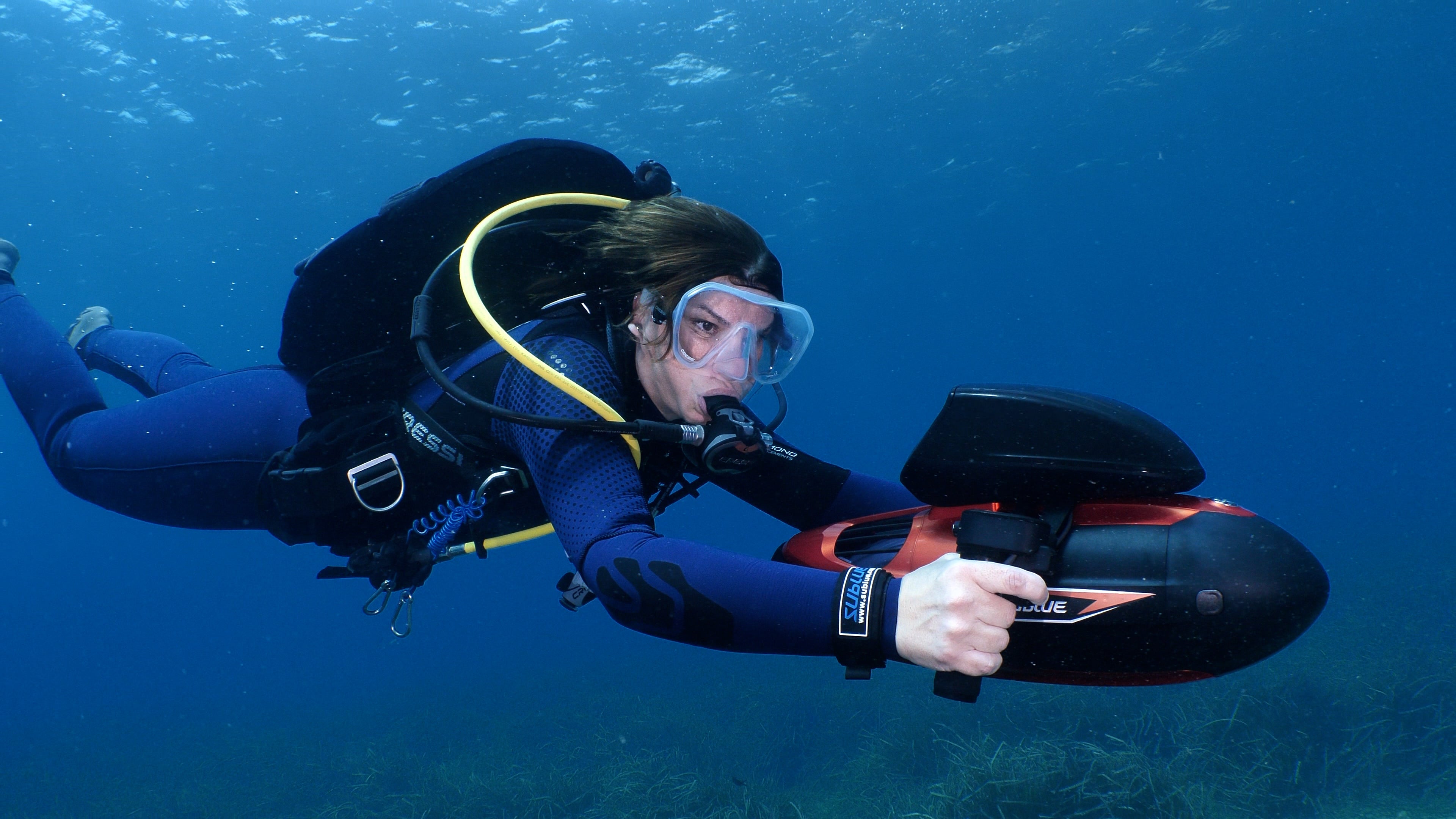

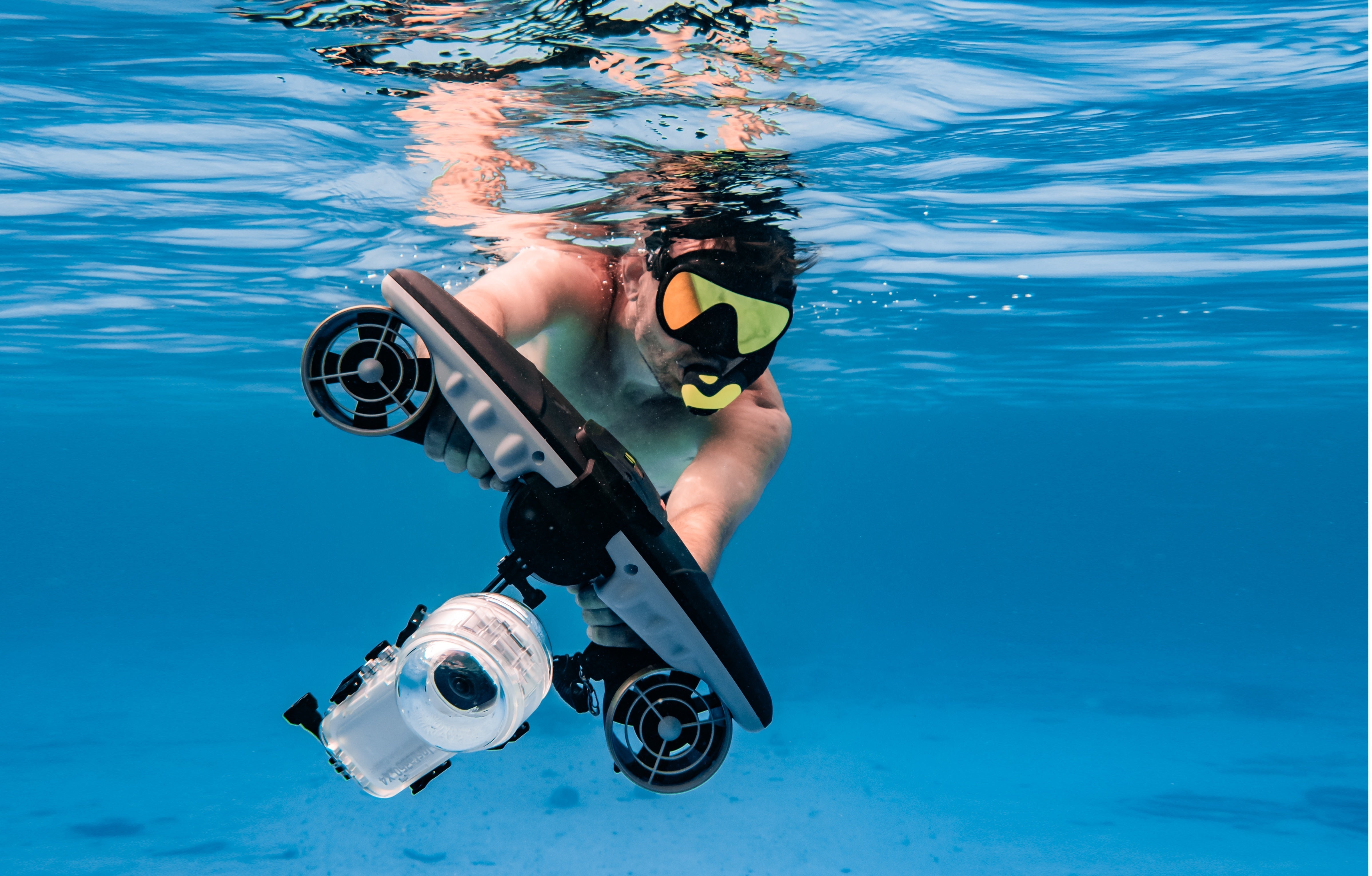
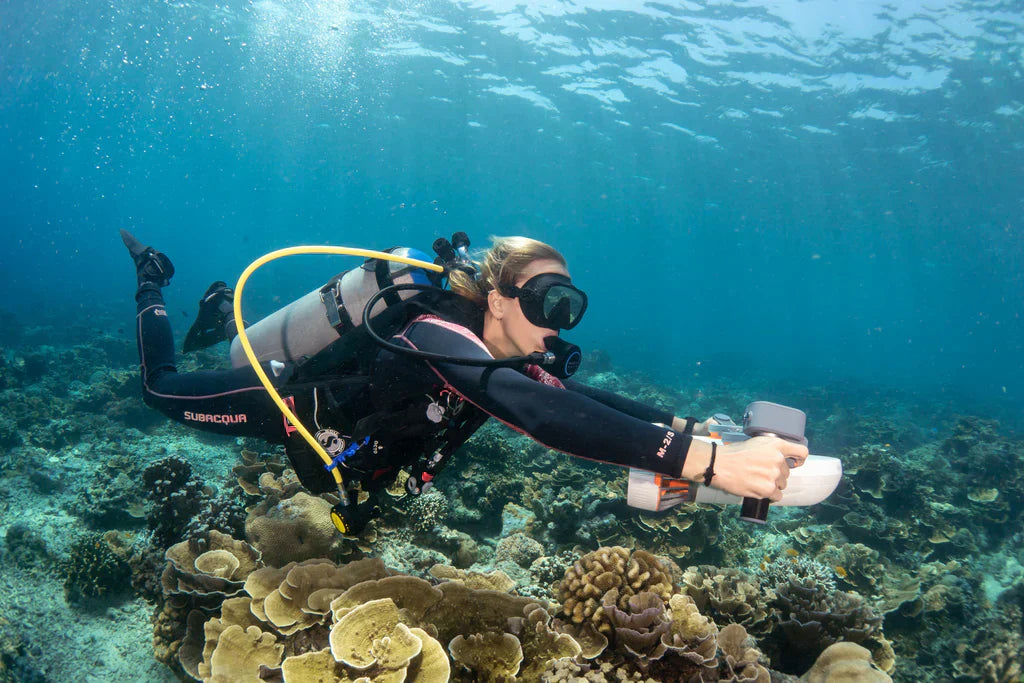
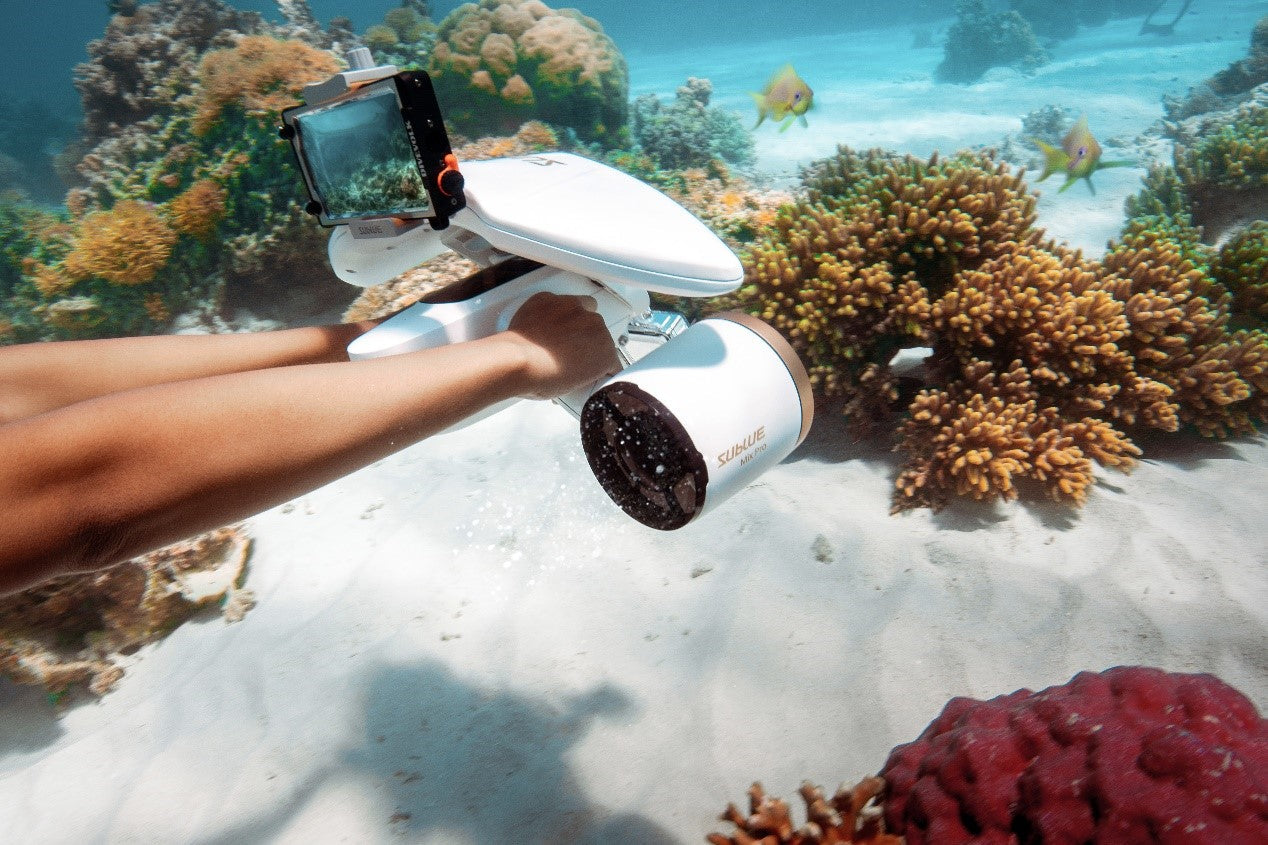
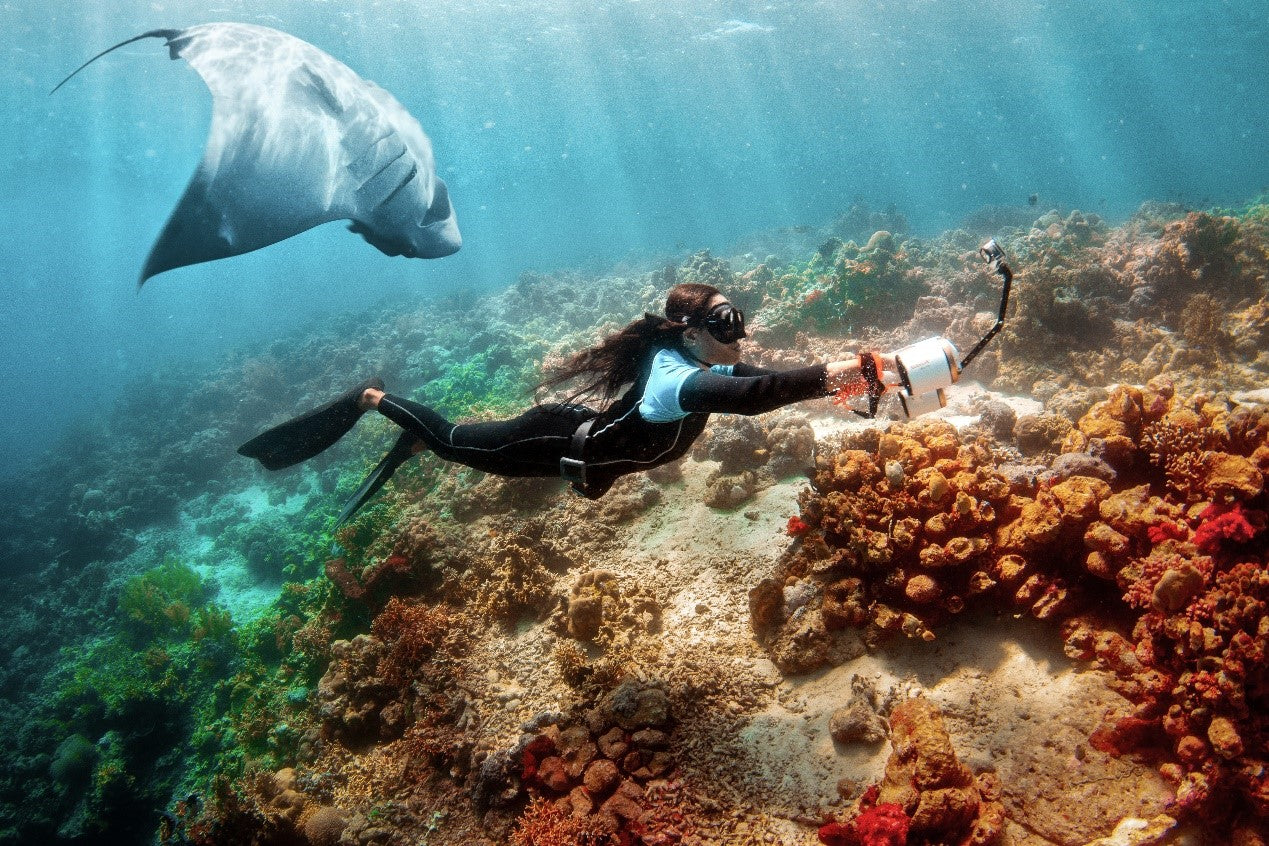
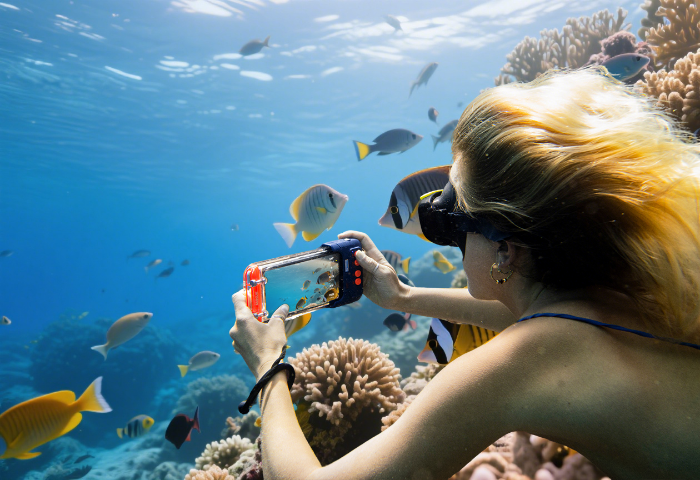
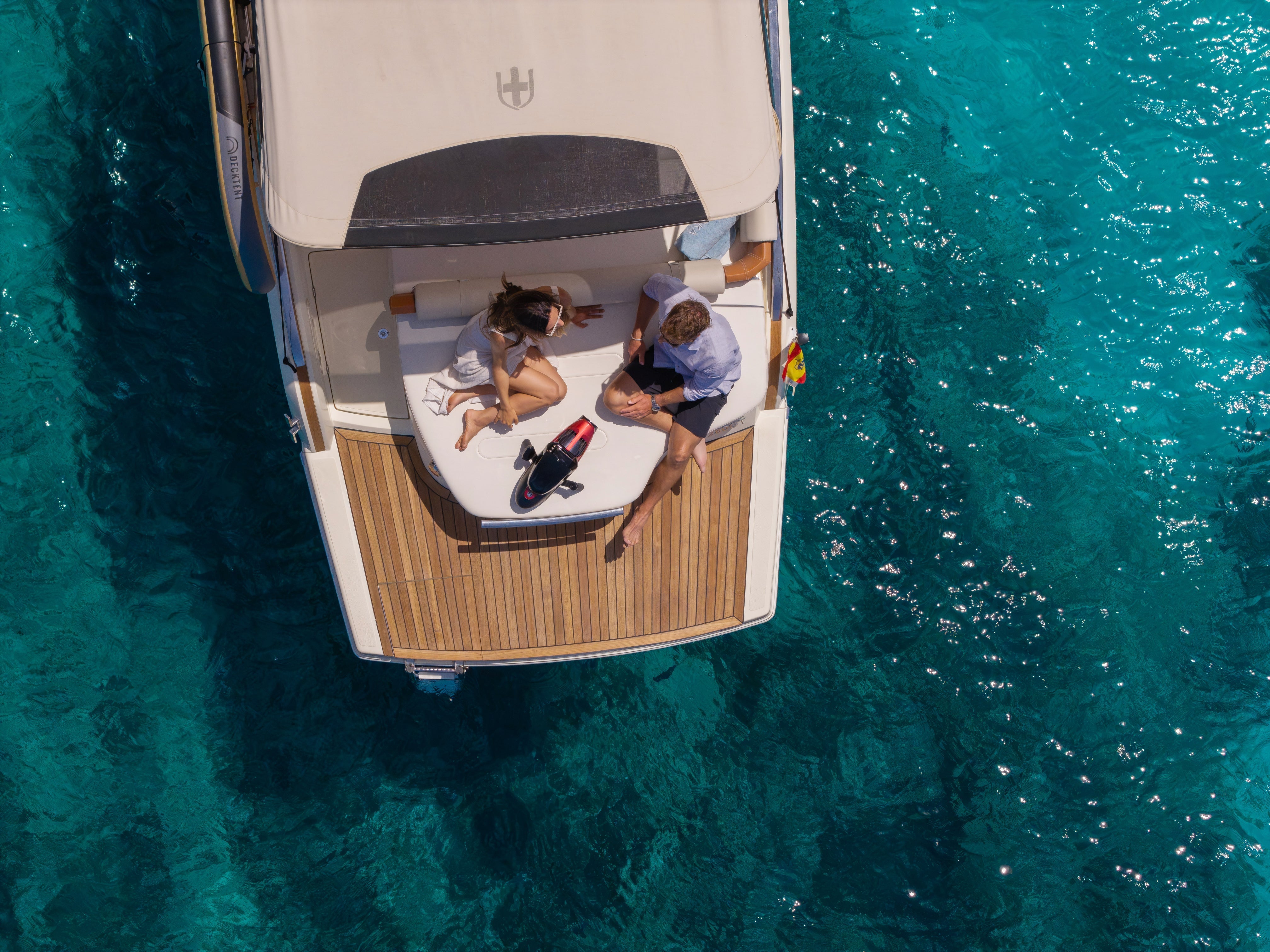
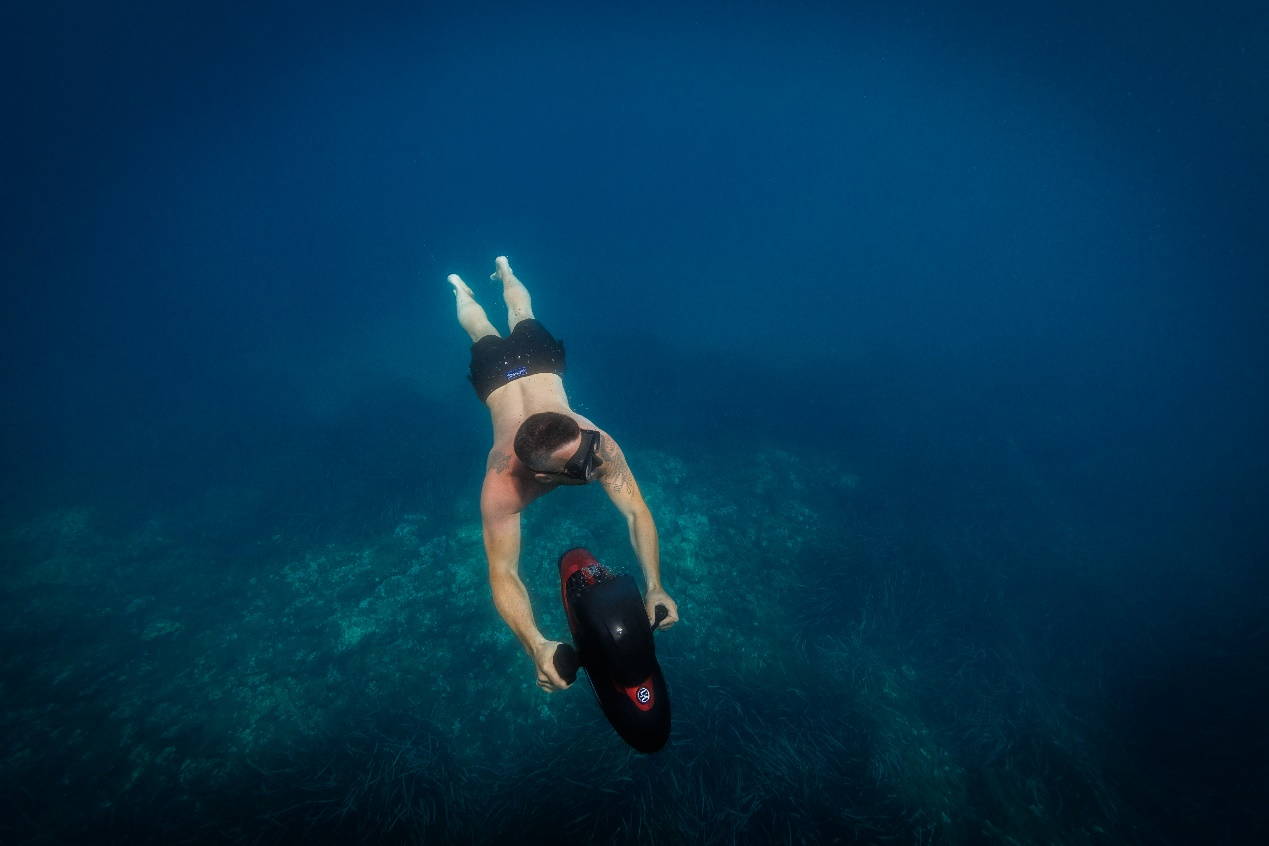
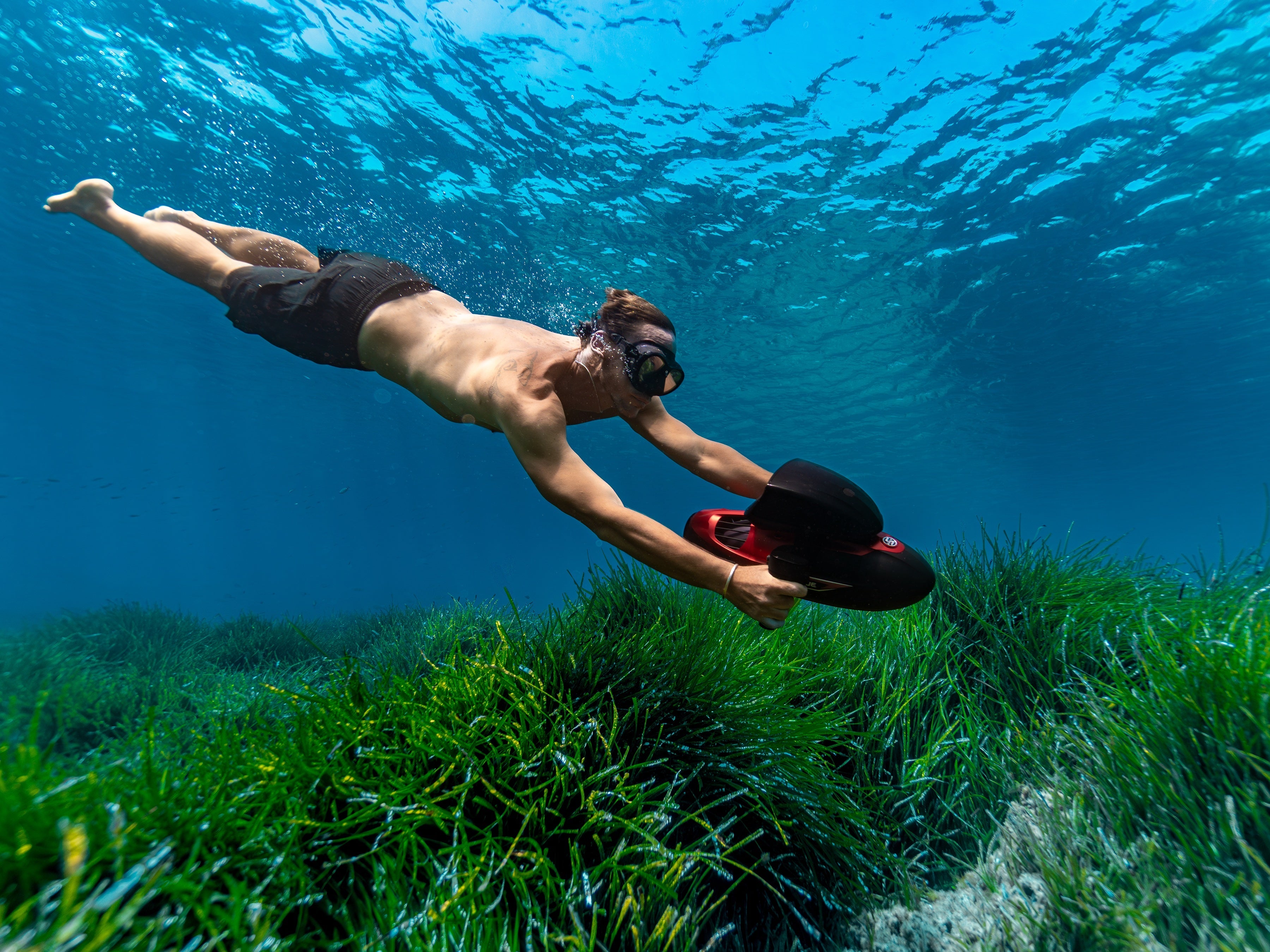

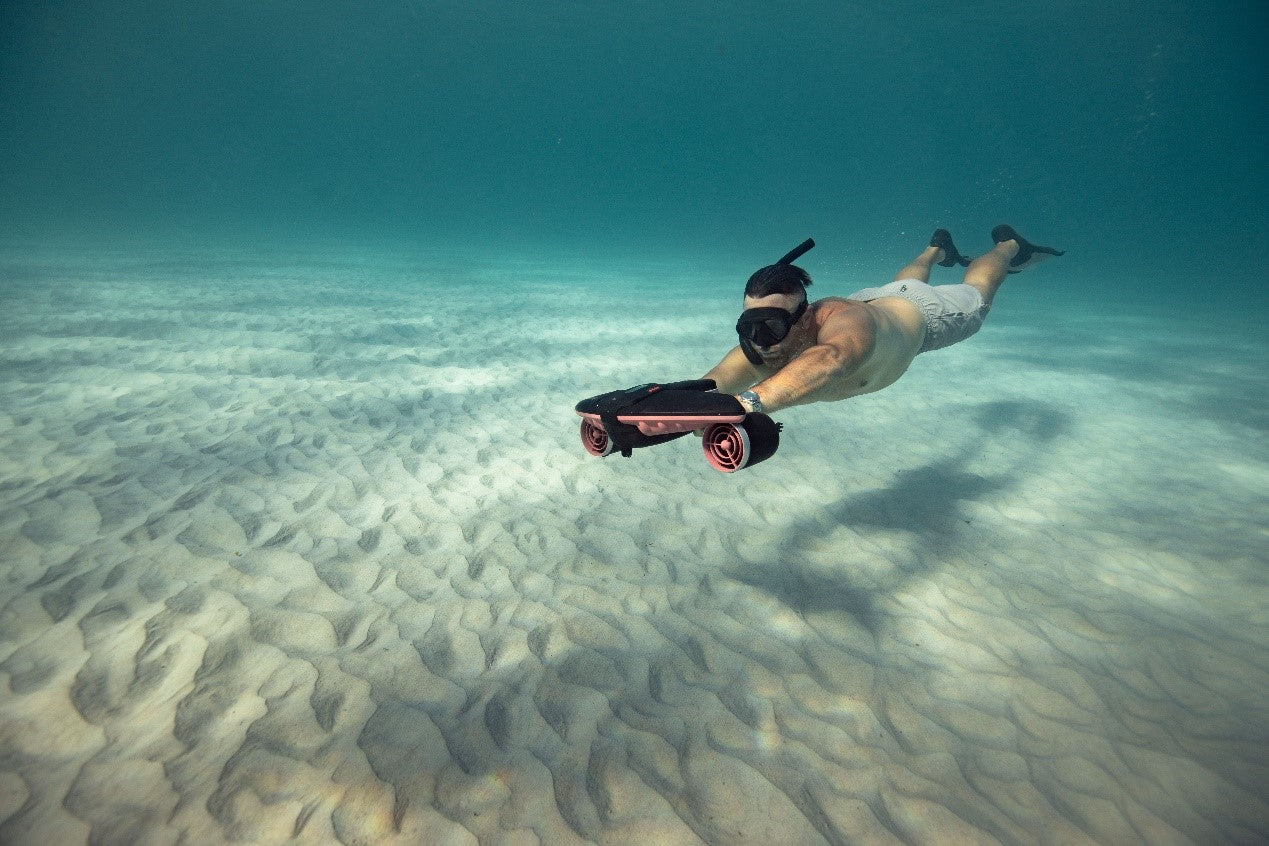
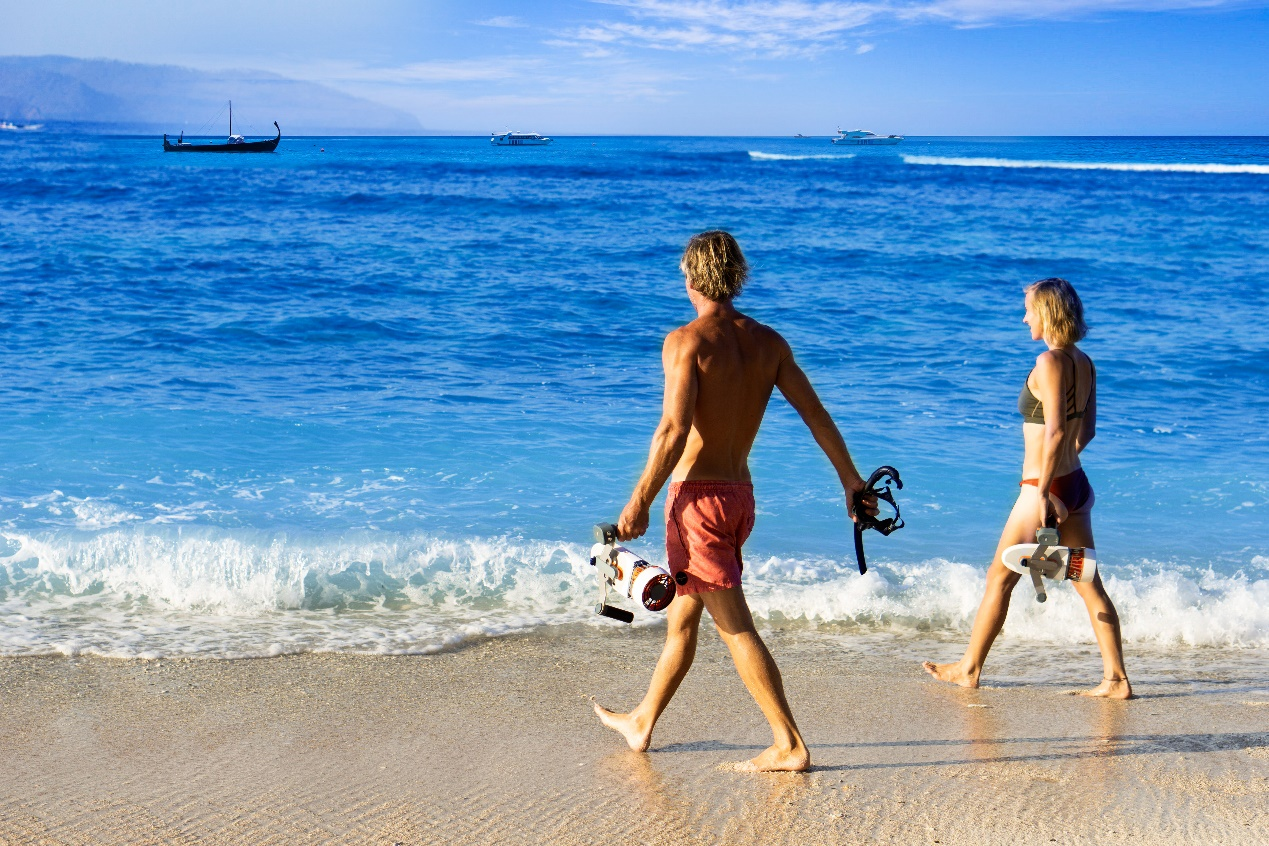
Del:
Den ultimate foreldreguiden til familie moro med undervannsscootere
Den ultimate guiden for undervannsscooter-videografer